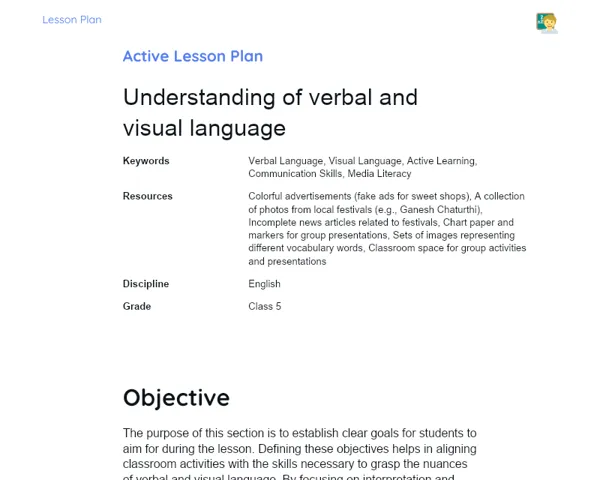Lesson Plan | Lesson Plan Tradisional | Alphabet and Sounds
| Keywords | English Alphabet, Vowels, Consonants, Letter Sounds, Letter Combinations, Pronunciation, Practical Examples, Reading, Writing, Communication, Curiosities, Review |
| Resources | Whiteboard, Markers, Eraser, Posters featuring the English alphabet, Support materials with word examples, Activity sheets, Audio clips of letter pronunciations, Projector (optional), Computer or tablet (optional) |
Objectives
Duration: (10 - 15 minutes)
This stage of the lesson plan aims to provide a comprehensive overview of the objectives that students should achieve. Clarifying these main objectives helps in focusing the lesson and ensures that both teachers and students are aligned on what is expected to be learned by the end of the session.
Objectives Utama:
1. Recognize and identify all the letters of the English alphabet.
2. Associate each letter with its respective sounds, noting that some letters can have multiple sounds.
Introduction
Duration: (10 - 15 minutes)
The purpose of this introductory stage is to contextualize students and generate interest in the topic. By sharing initial context and curiosities, students can feel a stronger connection to the content, aiding in understanding and retention. This introduction lays a solid groundwork for the detailed explanations to come, ensuring that students are both ready and eager to learn.
Did you know?
Did you know that the letter 'E' is the most frequently used letter in the English language? While it's prevalent, the sound of 'E' can vary quite a bit. Additionally, English is one of the few languages that doesn’t have a dedicated letter for the 'sh' sound, like in 'ship'. These sounds come from combinations of letters, which makes learning the alphabet even more intriguing.
Contextualization
To begin the lesson on the alphabet and sounds in English, it's crucial to engage the students on the topic. Explain that the English alphabet comprises 26 letters, which form the foundation of all written and spoken communication. Stress the importance of understanding these letters and the sounds they represent, as this knowledge is vital for accurate pronunciation, reading, and writing. Mention that while some letters have consistent sounds, others can change based on the words they're part of.
Concepts
Duration: (40 - 50 minutes)
This part of the lesson plan seeks to deepen students' understanding of the letters and sounds of the English alphabet by providing detailed and hands-on explanations. By covering each letter and its potential sounds, and discussing combinations, students should develop a clearer understanding of pronunciation nuances in English. The proposed questions allow students to apply their knowledge, reinforcing what they've learned.
Relevant Topics
1. Introduction to the English Alphabet: Discuss that the English alphabet consists of 26 letters, split into vowels (A, E, I, O, U) and consonants. Emphasize how each letter is essential for forming words and effective communication.
2. Vowels and Their Sounds: Explain the various sounds that each vowel can produce. For instance, the letter 'A' can sound like it does in 'cat', 'car', and 'cake'. Provide examples and encourage students to repeat the sounds to practice pronunciation.
3. Consonants and Their Sounds: Mention that just like vowels, certain consonants can have different sounds. Use examples such as the letter 'C', which can be pronounced /k/ as in 'cat' or /s/ as in 'cent'. Give additional word examples and have students pronounce them.
4. Letter Combinations: Discuss how specific combinations of letters form unique sounds, like 'sh' in 'ship' or 'ch' in 'chair'. Clarify that these combinations are common in English and crucial for achieving fluency in reading and speaking.
5. Practice with Common Words: Select familiar words that students might already recognize and ask them to identify the letters and sounds. Use words like 'apple', 'banana', 'cat', 'dog', etc. Ask students to read the words aloud, emphasizing the sounds of each letter.
To Reinforce Learning
1. What is the difference between the sounds of the letter 'C' in 'cat' and 'cent'?
2. Explain the different sounds that the letter 'A' can produce, giving examples.
3. What are some common letter combinations in English that create specific sounds? Provide examples.
Feedback
Duration: (20 - 25 minutes)
The aim of this feedback stage is to review and solidify students' learning, making sure they comprehend the explanations provided earlier. By discussing responses and engaging students in questions and reflections, the teacher can assess understanding and resolve any doubts, reinforcing the material learned. This interaction is essential for students to effectively apply their acquired knowledge in practical scenarios.
Diskusi Concepts
1. What is the difference between the sounds of the letter 'C' in 'cat' and 'cent'? 2. The letter 'C' has two distinct sounds based on its placement in words. In 'cat', it is pronounced /k/, similar to 'K'. In 'cent', it is pronounced /s/, like 'S'. This variation arises from English phonetic rules that determine the sound based on subsequent letters. 3. Explain the different sounds that the letter 'A' can produce, giving examples. 4. In English, the letter 'A' can produce several sounds: the /æ/ sound as in 'cat', the /ɑː/ sound as in 'car', and the /eɪ/ sound as in 'cake'. The sound changes depending on the word's context and surrounding letters. 5. What are some common letter combinations in English that produce distinct sounds? Provide examples. 6. Several letter combinations yield specific sounds in English: 'sh' gives /ʃ/ as in 'ship', 'ch' produces /tʃ/ as in 'chair', and 'th' can sound like /θ/ as in 'think' or /ð/ as in 'this'. Recognizing these combinations is key to understanding proper pronunciation.
Engaging Students
1. Encourage students to think of other words containing the letter 'C' and discuss the sounds in those instances. 2. Ask students to find words with the letter 'A' and categorize the different sounds it can make. 3. Suggest students create a list of words featuring the combinations 'sh', 'ch', and 'th' and examine the sounds they produce. 4. Inquire why understanding different letter combinations and their sounds is vital for learning English.
Conclusion
Duration: (15 - 20 minutes)
The aim of this concluding stage is to review and reinforce the key points addressed in the lesson, solidifying students' learning. By summarizing the main content, linking theory to practice, and underscoring the significance of the topic, this stage ensures that students recognize the importance of the subject matter and feel prepared to use it in real-life situations.
Summary
['The English alphabet consists of 26 letters, categorized into vowels and consonants.', 'Vowel sounds (A, E, I, O, U) can vary depending on the word.', "Similarly, consonants can have different sounds, like 'C', which can be pronounced as /k/ or /s/. ", "Combinations like 'sh', 'ch', and 'th' create unique sounds and are crucial for fluency.", 'Practicing with common words helped to illustrate the letters and their corresponding sounds.']
Connection
The lesson connected the theoretical understanding of the English alphabet and its sounds with practical application through clear examples and pronunciation exercises. By explaining each letter and its sounds, providing relatable examples, and allowing students to practice, the lesson helped ensure that students could apply theoretical knowledge effectively.
Theme Relevance
Grasping the alphabet and its sounds in English is fundamental for effective communication. Correct pronunciation and an understanding of sound variations in letters enhance reading, writing, and speaking skills. These competencies are crucial for academic and career success, especially in an increasingly globalized world where English is widely used.


